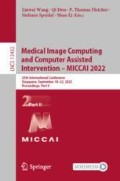Abstract
Cervical cancer is one of the primary factors that endanger women’s health, and Thin-prep cytologic test (TCT) has been widely applied for early screening. Automatic whole slide image (WSI) classification is highly demanded, as it can significantly reduce the workload of pathologists. Current methods are mainly based on suspicious lesion patch extraction and classification, which ignore the intrinsic relationships between suspicious patches and neglect the other patches apart from the suspicious patches, and therefore limit their robustness and generalizability. Here we propose a novel method to solve the problem, which is based on graph attention network (GAT) and supervised contrastive learning. First, for each WSI, we extract and rank a large number of representative patches based on suspicious cell detection. Then, we select the top-K and bottom-K suspicious patches to construct two graphs seperately. Next, we introduce GAT to aggregate the features from each node, and use supervised contrastive learning to obtain valuable representations of graphs. Specifically, we design a novel contrastive loss so that the latent distances between two graphs are enlarged for positive WSIs and reduced for negative WSIs. Experimental results show that the proposed GAT method outperforms conventional methods, and also demonstrate the effectiveness of supervised contrastive learning.
Access this chapter
Tax calculation will be finalised at checkout
Purchases are for personal use only
References
Chang, C.W., et al.: Automatic segmentation of abnormal cell nuclei from microscopic image analysis for cervical cancer screening. In: 2009 IEEE 3rd International Conference on Nano/Molecular Medicine and Engineering, pp. 77–80 (2009)
Cheng, S., et al.: Robust whole slide image analysis for cervical cancer screening using deep learning. Nature Commun. 12, 5639 (2021)
Du, X., Huo, J., Qiao, Y., Wang, Q., Zhang, L.: False positive suppression in cervical cell screening via attention-guided semi-supervised learning. In: Rekik, Islem, Adeli, Ehsan, Park, Sang Hyun, Schnabel, Julia (eds.) PRIME 2021. LNCS, vol. 12928, pp. 93–103. Springer, Cham (2021). https://doi.org/10.1007/978-3-030-87602-9_9
He, K., Zhang, X., Ren, S., Sun, J.: Deep residual learning for image recognition. In: Proceedings of the IEEE Conference on Computer Vision and Pattern Recognition, pp. 770–778 (2016)
Hu, J., Shen, L., Sun, G.: Squeeze-and-excitation networks. In: Proceedings of the IEEE Conference on Computer Vision and Pattern Recognition, pp. 7132–7141 (2018)
Kale, A., Aksoy, S.: Segmentation of cervical cell images. In: 2010 20th International Conference on Pattern Recognition, pp. 2399–2402 (2010)
Kim, K.B., Song, D.H., Woo, Y.W.: Nucleus segmentation and recognition of uterine cervical pap-smears. In: International Workshop on Rough Sets, Fuzzy Sets, Data Mining, and Granular-Soft Computing, pp. 153–160 (2007)
LeCun, Y., Bengio, Y., Hinton, G.: Deep learning. Nature 521(7553), 436–444 (2015)
Lin, T.Y., Goyal, P., Girshick, R., He, K., Dollár, P.: Focal loss for dense object detection. In: Proceedings of the IEEE international conference on computer vision, pp. 2980–2988 (2017)
Liu, Y., Zhang, L., Zhao, G., Che, L., Zhang, H., Fang, J.: The clinical research of Thinprep Cytology Test (TCT) combined with HPV-DNA detection in screening cervical cancer. Cell Mol. Biol. (Noisy-le-grand) 63(2), 92–95 (2017)
Van der Maaten, L., Hinton, G.: Visualizing data using t-SNE. J. Mach. Learn. Res. 9(86), 2579–2605 (2008)
Mariarputham, E.J., Stephen, A.: Nominated texture based cervical cancer classification. Comput. Math. Methods Med. 2015, 1–10 (2015)
Nayar, R., Wilbur, D.C. (eds.): The Bethesda System for Reporting Cervical Cytology. Springer, Cham (2015). https://doi.org/10.1007/978-3-319-11074-5
Schiffman, M., Castle, P.E., Jeronimo, J., Rodriguez, A.C., Wacholder, S.: Human papillomavirus and cervical cancer. The Lancet 370(9590), 890–907 (2007)
Shi, J., Wang, R., Zheng, Y., Jiang, Z., Zhang, H., Yu, L.: Cervical cell classification with graph convolutional network. Comput. Methods Programs Biomed. 198, 105807 (2021)
Solomon, D., Breen, N., McNeel, T.: Cervical cancer screening rates in the united states and the potential impact of implementation of screening guidelines. CA Cancer J. clin. 57(2), 105–111 (2007)
Veličković, P., Cucurull, G., Casanova, A., Romero, A., Liò, P., Bengio, Y.: Graph attention networks. In: International Conference on Learning Representations (ICLR)), pp. 1–12 (2017)
Wright, A.M., et al.: Digital slide imaging in cervicovaginal cytology: a pilot study. Arch. Pathol. Lab. Med. 137(5), 618–624 (2013)
Yang, D.X., Soulos, P.R., Davis, B., Gross, C.P., Yu, J.B.: Impact of widespread cervical cancer screening: number of cancers prevented and changes in race-specific incidence. Am. J. Clin. Oncol. 41(3), 289 (2018)
Yi, L., Lei, Y., Fan, Z., Zhou, Y., Chen, D., Liu, R.: Automatic detection of cervical cells using dense-cascade R-CNN. In: Chinese Conference on Pattern Recognition and Computer Vision (PRCV), pp. 602–613 (2020)
Zhou, M., et al.: Hierarchical pathology screening for cervical abnormality. Comput. Med. Imaging Graph. 89, 101892 (2021)
Zhou, M., et al.: Hierarchical and robust pathology image reading for high-throughput cervical abnormality screening. In: International Workshop on Machine Learning in Medical Imaging, pp. 414–422 (2020)
Zhu, X., et al.: Hybrid AI-assistive diagnostic model permits rapid TBS classification of cervical liquid-based thin-layer cell smears. Nat. Commun. 12(1), 1–12 (2021)
Author information
Authors and Affiliations
Corresponding author
Editor information
Editors and Affiliations
Rights and permissions
Copyright information
© 2022 The Author(s), under exclusive license to Springer Nature Switzerland AG
About this paper
Cite this paper
Zhang, X. et al. (2022). Whole Slide Cervical Cancer Screening Using Graph Attention Network and Supervised Contrastive Learning. In: Wang, L., Dou, Q., Fletcher, P.T., Speidel, S., Li, S. (eds) Medical Image Computing and Computer Assisted Intervention – MICCAI 2022. MICCAI 2022. Lecture Notes in Computer Science, vol 13432. Springer, Cham. https://doi.org/10.1007/978-3-031-16434-7_20
Download citation
DOI: https://doi.org/10.1007/978-3-031-16434-7_20
Published:
Publisher Name: Springer, Cham
Print ISBN: 978-3-031-16433-0
Online ISBN: 978-3-031-16434-7
eBook Packages: Computer ScienceComputer Science (R0)


